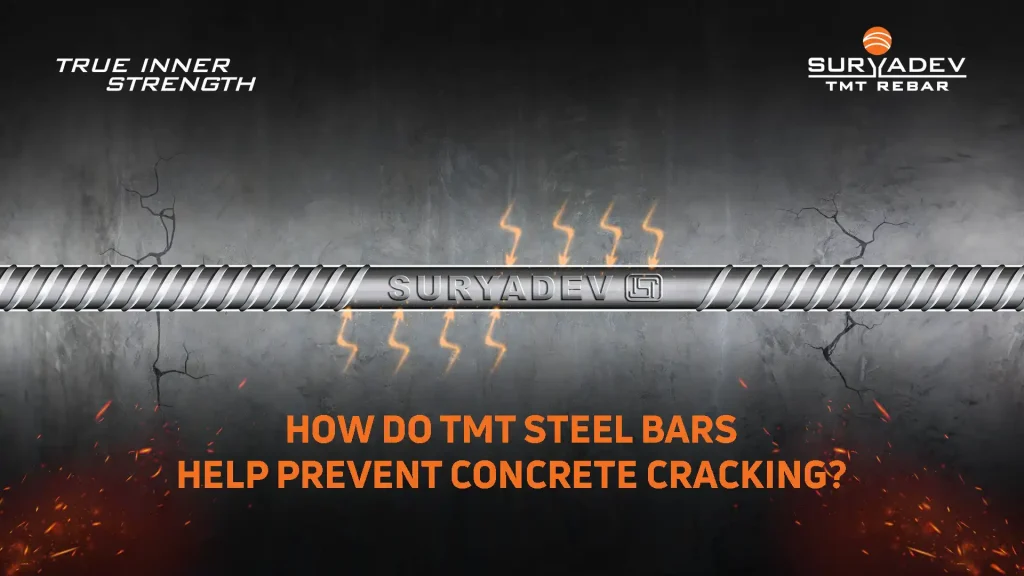
Concrete forms the foundational aspect of a building construction. Yet, cracking is a major problem persistent in concrete structures. It impacts the strength, structural integrity, and longevity of the building. The good news is that it can be prevented. TMT steel bars help provide a strong reinforcement that increases the resilience of the building structures and prevents cracking.
In this blog, we have covered the different types of cracking and insights into how TMT steel bars can help enhance the load-bearing capacity. Read the blog for in-depth insights on preventing concrete cracking and make informed decisions to protect your structural integrity.
Types of cracks
Concrete cracks can happen due to different factors. It could be a material defect, excessive loads, heat, corrosion, etc. The following are some of the major types of concrete cracks that usually happen in buildings.
1. Shrinkage cracks
Shrinkage cracks usually result from the shrinking and drying of concrete. They appear in web patterns at random spots across the surface. Though they are not a dire concerning subject, they may impact the aesthetic appeal. Shrinkage cracks also allow water to seep in leading to other damages.
2. Settlement cracks
Settlement cracks occur due to uneven settling of concrete. This can happen either due to poor soil conditions, changes in moisture, improper compaction, overloading, etc. They indicate a serious issue and they are usually diagonal or vertical. If they are wide, or accompanied by other issues like leaning walls, they require immediate attention.
3. Thermal cracks
Thermal cracks occur due to temperature changes, which cause contraction and expansion of concrete. It can also occur when we use materials with different thermal expansion abilities and properties. For instance, when you use concrete and steel, cracking can occur when steel and concrete expand or contract at two different rates.
4. Hairline cracks
As the name indicates, hairline cracks are thin and not a serious issue. Yet, it is important to observe hairline cracks as they may be a reflection of other problems in the foundation.
Role of TMT steel bars
TMT (Thermo Mechanically Treated) bars are reinforcement steel used as support in columns, beams, and other structures to distribute load evenly across them. The thermo-mechanical treatment enhances their mechanical properties. TMT bars are known for their strength and durability.
How can TMT steel bars prevent different types of concrete cracking? We have got this covered in the coming section.
1. Superior tensile strength
When compared to traditional steel bars, TMT steel bars have a greater tensile strength. The greater inherent strength helps resistant the tensile forces and withstand stress caused by them. As TMT bars can absorb the tensile stress in concrete, they help minimise shrinkage cracks.
2. Corrosion resistance
A major cause for concrete cracking is corrosion of the steel bars. Rust formation and expansion increases the pressure and eventually, leads to cracking. In the course of the manufacturing process, the TMT bars are coated with protective elements that prevent corrosion and keep the rust at bay. The anti-corrosion properties of the TMT bars protect the concrete and enhance the integrity of your building.
3. High ductility
TMT bars have greater ductility which enables TMT bars to deform without breaking. Also, high ductility means the TMT bars can withstand exposure to high thermal resistance and very high temperatures. This prevents thermal cracking and other forms of concrete cracking formed due to heat exposure.
4. High bonding strength
TMT steel bars come with high bonding strength which helps distribute the load equally across the structure. The evenly distributed load helps minimise sheer failures and settlement problems that lead to cracks.
5. Greater flexibility
TMT bars have high flexibility when compared to the traditional bars. The increased flexibility of the concrete makes them resilient to soil movement usually caused by freeze-thaw cycles. They occur due to temperature fluctuations that causes water to freeze/thaw. This reduces the possibility of frost heave cracks, caused by expansion and contraction of soil.
6. Durability and longevity
As TMT bars bond well with the concrete and ensure equal distribution of the load, they reduce the chances of cracks. They enhance the structural integrity, durability, and lifespan of concrete structures.
Closing Thoughts
Overall, understanding the different types of concrete cracking helps take preventive measures to ensure the longevity of buildings. The cracks must be checked appropriately as they may damage the integrity of the building ultimately causing a structural damage. The cracks occur mostly due to shrinkages, temperature changes, or improper load distribution.
Using TMT steel bars help mitigate the risk of concrete cracking and achieve equal distribution of load. This reduces the stress on the concrete structure. Also, the TMT bars have greater tensile strength, ductility, and high bonding strength. This prevents settlement and shrinkage cracks. Using high-quality, TMT bars enhances the safety and structural integrity of your building while also reducing the maintenance costs.
Suryadev is a renowned market leader in TMT steel bars manufacturing. The TMT bars can be customized to your unique requirements on grade and sizes. As a leading TMT bars manufacturer, deliver high-quality products at affordable prices.
If you are looking for the best TMT bars for concrete, Suryadev TMT bars are your go-to. Contact us at https://suryadev.in/
FAQs
1. What causes concrete cracks?
Concrete cracks are caused by high temperatures, imbalance in load sharing, corrosion, shrinkage, uneven soil settlements, water seepage, freeze/thaw conditions, and defects in construction.
2. How to use TMT steel bars to prevent concrete cracks?
While using TMT steel bars, ensure that they are of reputed grades (Eg. Fe 500 or 550). Also, while placement, ensure accuracy and proper alignment. Covering of TMT bars helps protect against corrosion. TMT steel bars have high inherent tensile strength, bonding strength, and ductility. All these ensure that the load gets distributed equally, while protecting the concrete from cracks.
